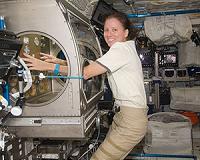 |
Boulder CO (SPX) Jul 27, 2010 Ball Aerospace and Technologies, Lockheed Martin Space Systems Company and NASA conducted a successful technology demonstration of an inventive navigation system that will make docking operations safer and easier for spacecraft flying to the International Space Station (ISS). The demonstration that took place at the Ball facility in Boulder, Colo., showcased the dynamic nature of the sensors by simulating crewed and uncrewed docking operations. This docking navigation system prototype was developed collaboratively by NASA, Ball and Lockheed Martin and will be tested by astronauts aboard STS-134 in an unprecedented on-orbit maneuver during the space shuttle mission to the ISS in February 2011 as part of the Sensor Test for Orion Relative Navigation Risk Mitigation (STORRM) Development Test Objective (DTO). On Flight Day 11 of the mission, the shuttle crew will undock from the ISS and then re-rendezvous with the station on an Orion-like approach. NASA's Orion crew exploration vehicle is at the peak of its development phase, which has spurred several new technologies and innovations in composites, structures, thermal protection systems, avionics and navigation systems. Because of its capability to determine shapes, intensity, and distance, STORRM's sensing technology may also improve a variety of Earth-bound applications such as terrain mapping, deforestation monitoring and transportation hazardous avoidance systems. STORRM's hardware consists of two sensors: the eye-safe flash LiDAR Vision Navigation Sensor (VNS) and the high definition Docking Camera (DC) developed by Ball, as well as avionics and flight software developed by NASA Langley Research Center. Both sensors will be used on the Orion spacecraft to provide real-time three-dimensional images to the crew with a resolution 16 times higher than the current shuttle sensors. This next generation system also provides data from as far away as three miles - three times the range of the shuttle docking system. The single-system design provides the required docking accuracy and range capability necessary to meet Orion's crew safety, mass, volume and power constraints. "The effective demonstration of Ball's VNS and DC on the ground makes us all the more eager to see the STS-134 astronauts test the system aboard Endeavour," said David L. Taylor, president and CEO of Ball Aerospace. The STORRM sensing functions that will be demonstrated during docking, undocking and re-rendezvous operations on STS-134 have been identified as a critical technology needed for space exploration missions of the future. During STS-134, data will be collected and the crew members will be able to monitor the data through the STORRM software application on a computer. In addition, screen snapshots of the data will be sent to mission control by S-Band video for the STORRM team to evaluate during the mission. "This innovative technology enhances the Orion team's ability to significantly improve crew safety for human space flight," said Larry Price, Orion deputy program manager for Lockheed Martin. "Once proven successful on orbit, this system will enable us to continue on our path forward to safely fly Orion in 2013." Lockheed Martin is the prime contractor to NASA for the Orion Project and leads the industry team that includes major subcontractors as well as a network of minor subcontractors and small businesses working at 88 facilities in 28 states. In addition, the program contracts with more than 500 small businesses across the United States through its expansive supply chain network.
Share This Article With Planet Earth
Related Links Lockheed Martin Ball Aerospace and Technologies Station at NASA Station and More at Roscosmos S.P. Korolev RSC Energia Watch NASA TV via Space.TV Space Station News at Space-Travel.Com
 ISS Crew Perform Spacewalk
ISS Crew Perform SpacewalkHouston TX (SPX) Jul 27, 2010 The members of the International Space Station's Expedition 24 crew shifted their sleep schedule Monday in preparation for their mission's first spacewalk, waking up at about 2:40 p.m. EDT. Flight Engineers Fyodor Yurchikhin, a veteran of three spacewalks in 2007 during Expedition 15, and Mikhail Kornienko, a spacewalk rookie, will perform the six-hour spacewalk. The pair will exit the Pir ... read more |
|
| The content herein, unless otherwise known to be public domain, are Copyright 1995-2010 - SpaceDaily. AFP and UPI Wire Stories are copyright Agence France-Presse and United Press International. ESA Portal Reports are copyright European Space Agency. All NASA sourced material is public domain. Additional copyrights may apply in whole or part to other bona fide parties. Advertising does not imply endorsement,agreement or approval of any opinions, statements or information provided by SpaceDaily on any Web page published or hosted by SpaceDaily. Privacy Statement |